| Mothim | |||
|---|---|---|---|
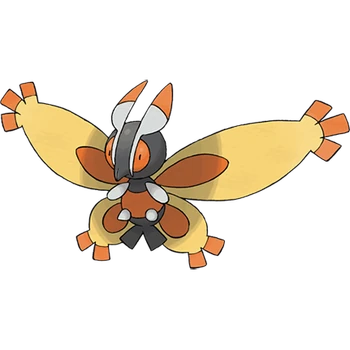 | |||
| General information | |||
| Universe | Pokémon | ||
| Aliases | Larva: ミノムッチ (Minomucchi) Adult Females: ミノマダム (Minomadam) Males Only: ガーメイル (Gāmeiru, Gamale) | ||
| Environment | Regions of Hoenn, Kalos, Kanto, Sinnoh, Unova | ||
| Intelligence | Non-sapient | ||
| Biochemistry | Carbon-based lifeform | ||
| Biological information | |||
| Reproduction | Sexual; lays eggs | ||
| Average height | Larva: 0'08" (0.2 m) Female: 1'08" (0.5 m) Male: 2'11" (0.9 m) | ||
| Average weight | Larva: 7.5 lbs. (3.4 kg) Female: 14.3 lbs. (6.5 kg) Male: 51.4 lbs. (23.3 kg) | ||
| Locomotion | Larva: Immobile Female: Immobile Male: Powered flight | ||
| Feeding behavior | Nectarivorous | ||
| Skin color | Black | ||
| Lineage information | |||
| Related species | Forretress | ||
| Cultural information | |||
| Language(s) | Understand language of trainer | ||
| Sociocultral characteristics | |||
| Scientific taxonomy | |||
| Other information | |||
| Status | Least Concern | ||
| Creator | Arceus | ||
Mothims are a species of nectarivorous bagworm moth. They are closely related to Forretress. They naturally appear throughout the regions of Hoenn, Kalos, Kanto, Sinnoh, Unova, but have been found in other regions by being brought there as companions of trainers.
Lifecycle[]
Burmy[]
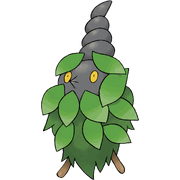
A Plant Burmy, as seen in the wild.
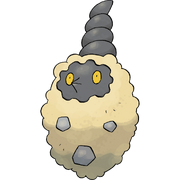
Sandy shells only develop in areas with sand.
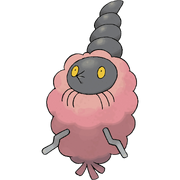
A Trash shells are constructed in civilized areas like cities.
Larval instar forms of Mothim are known as Burmies. To protect themselves from the cold, wintry winds of their indigenous regions, they use leaves, twigs, and branches to form a cloak around themselves. This casing will be thinner if built when it is cold out. Interestingly however, they will build their casings out of alternate materials when available, similar to caddises. Wild, feral, and domesticated Burmies after each and every battle, discarding its damaged case for a new one - whether outside in regular or tall grass. However, even if they are born in an area without cocooning materials, they will somehow still find a way to build one. Domesticated Burmies will develop non-floral cloaks: They will gather sand from the insides of caves, on beaches, or near to honey trees; trash (primarily insulation) from buildings.
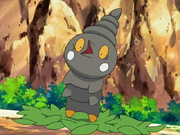
The exposed body of a Burmy.
Burmies have black, caterpillar bodies with their mandibles adapted into a beak. They have six legs, unlike most caterpillars, with the front two pairs being black like the body and the hindlegs having orange markings. Along the sides of their head they have two white spots. Uniquely they have a pair of long antennae that curl up along their head and that they use to attach to areas and hang from. Their eyes are yellow in hue and have pseudopupils. Male and female Burmies are indistinguishable from one another until they reach maturation, at which point they display significant sexual dimorphism.
Wormadam[]
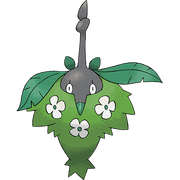
A Plant Wormadam.
Female Burmies strengthen their case and mature into Wormadams as they reach sexual maturity. Their bodies are black in color. Unlike males, Wormadams don't have wings. Although most of their bodies are hidden inside their casing, what can be determined from their physiology includes oval eyes with what are presumably pseudopupils, and a long pointed beak-life proboscis. They use a pair of merged antennae to latch with a developed coiled tip to attach to locations.
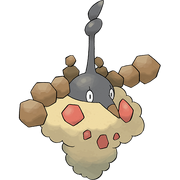
A Sandy Wormadam.
Unlike their instar form, Wormadams can no longer shed their case as it has permanently fused to their body. Because of this, Wormadams can be found in "cloaks" made of plant material, sand, or even trash dependent upon where they finally reached their maturity. This final cloak may differ from whatever they wore last as a Burmy, as they will build a new case as they metamorphose, taking in surrounding materials on hand in the area. Through unknown means, the casing develops makeshift arms for the Wormadam to manipulate her environment with. Interestingly, reaching maturity on a cold day will actually leave them with a thicker coat.
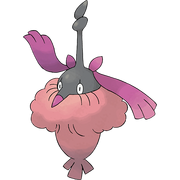
A Trash Wormadam.
Those wearing a Plant Cloak oftentimes have several white flowers that bud around the case, their cloak "arms" are large leaves, and their proboscis develops a green tip. Those in Trash Cloaks develop a pink-tipped proboscis and a case made out of building insulation, with dark pink ribbons to serve as arms. In Sandy Cloaks, their case will be made of reddish brown rocks, with chains of pebbles held together for to serve as arms.
Mothim[]
Male Burmies metamorphose into Mothim as they reach sexual maturity. While their bodies are primarily black like the rest of their species, they have four gray legs and an orange patch on the underside of their thorax, perhaps to better identify each other from a distance or for mating dance purposes; as well as a gray stripe down their backs. Like other lepidopterans, they have two sets of wings, with their hindwings being smaller and rounder than their more ovalloid primary forewings. These wings are primarily tan in color although a basic, orange oval marking lies near their base and with similarly orange fringe on the edges of each wing. They hold their wings flat, perpendicular to the ground. However, unlike other lepidopterans they have a set of feathered cerci that look squared from a distance. Their eyes are orange with a small black pseudopupil on each, while their feathery antennae are mostly gray with orange tips.
Mothims are nocturnal and are not territorial by nature and have no particular habitat of their own; instead of keeping a nest, they wander nomadically across the home region (generally fields and mountainous areas) in search of their source of sustenance: Combee honey. As a whole they are kleptoparasitic—instead of gathering their beloved nectar themselves they instead flutter into Combee hives at night and steal already-prepared honey.
Trivia[]
- There are some grassy areas in which Burmy will not change to a Plant Cloak. In Pokémon X and Y, Burmy will change to Sandy Cloak rather than Plant Cloak after battling in the grassy areas of Route 8 between Connecting Cave and Ambrette Town, presumably due to the proximity to the beach on Route 8 connecting Ambrette Town to Cyllage City.